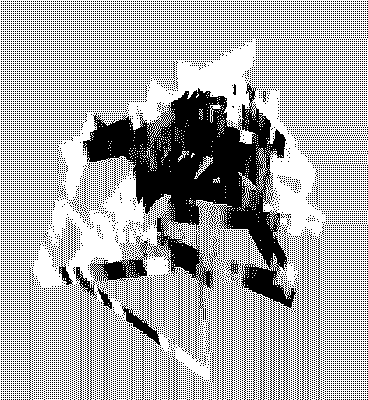
Let's try the argument from the previous post again, from a slightly different angle.
Will Brand says:
The preference for GIF as a medium, it seems to me, has nothing to do whatsoever with its compression algorithms, a teensy bit to do with the retro appeal of a limited color palette, and a whole lot to do with the fact that - as the very existence of your remix culture indicates - it's so easily interchanged.
That was after I questioned whether the word "interchange" in the acronym Graphics Interchange Format was the main reason someone might use the GIF format. My revised reply:
The reason the GIF above, by stage, got six "faves" on dump.fm and five "likes" on Google Reader probably isn't because people thought, "oh this is something I can remix" but rather because it appeals on a more fundamental level: a combination of visual poetry, psychological investigation, critique, and humor.
(The rhetoric strengthens when the GIF show's square peg isn't semi-apologetically talking about something he made.) Let's flesh it out some more. Stage's GIF could be remixed but why would it be? It feels complete, hard to improve on. A dense, convoluted highway of interlocking triangles (which probably started as an automatic, scribbly gesture in a 3D drawing program of some kind) bobs lasciviously; it's the kind of robotic, sexualized reduction that so intrigued Marcel Duchamp in works from the Large Glass to the rotoreliefs. There is also a bobbing countermotion: a black blur passes from right to left in a way that is difficult to puzzle out even though it's right in front of your eyes.
This rocking and scrolling movement leaves indexical traces of itself on two axes: in the upper right thin scan lines make an intriguing horizontal pattern, while below thicker lines suggest a column or waterfall. Anchoring all this movement, mutely indifferent to it, is an unmoving field of dots, a grey matrix both apart from but completely integrated into the "foreground" activity.
This mesh of effects and counter-scenarios exists by the simplest of means, a couple dozen frames that can be read instantly on any computer browser. It could be juxtaposed with other images, placed on web pages with ads and porn, accompanied by text struggling to explain it but it's always going to read as an autonomous work. This is why the GIF format appeals to artists: the possibility that a quirky, inviolate, individuated expression can emerge that will be better than bulletin boards, better than process, better than overdetermined academic ideas of relational, groupcentric, faux-interactive art.
